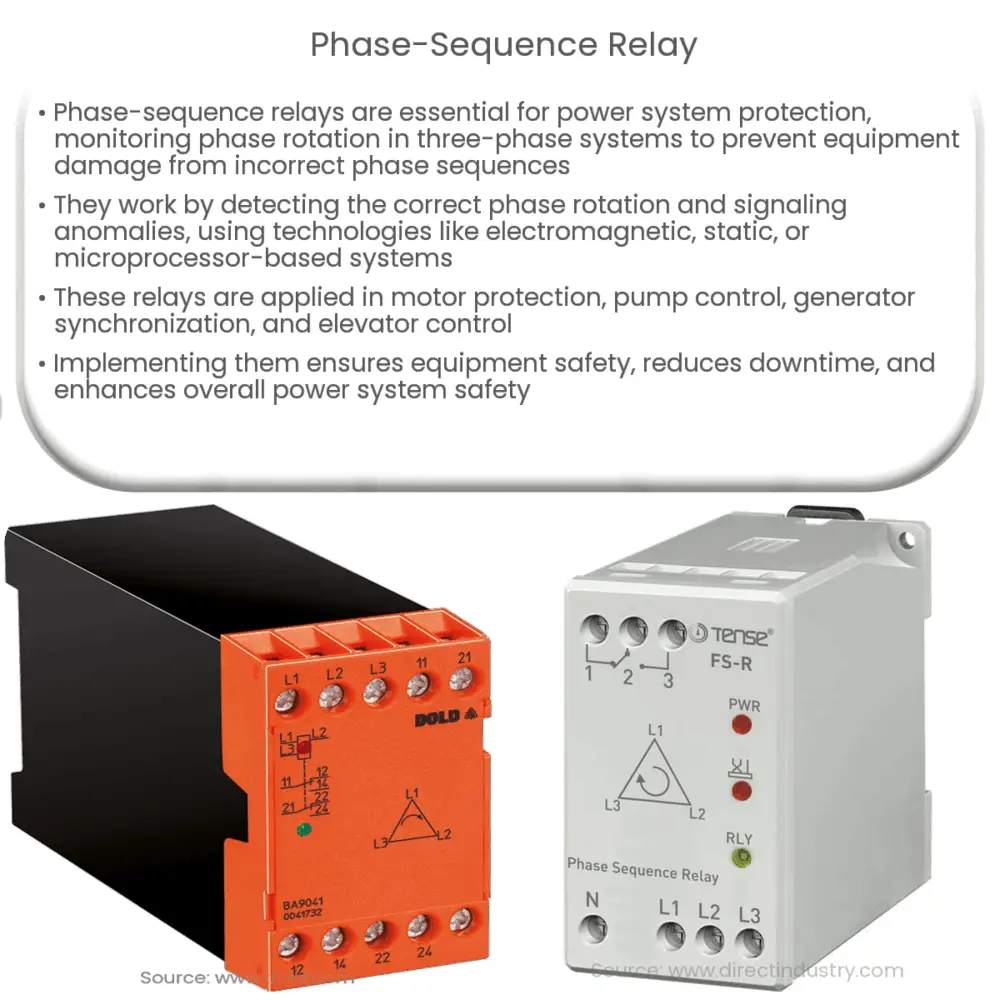A phase-sequence relay monitors phase rotation in three-phase systems, protecting equipment from damage due to incorrect or reversed phase order.

Phase-Sequence Relay: An Essential Component in Power System Protection
Introduction
A phase-sequence relay is a crucial element in power system protection, specifically designed to monitor the phase rotation in three-phase electrical systems. It is widely used in industries and commercial applications to safeguard equipment from potential damage due to phase sequence reversal or incorrect phase sequence. This article aims to provide an in-depth understanding of the phase-sequence relay, its working principle, applications, and benefits.
Working Principle
The phase-sequence relay operates based on the order of the incoming voltage phases (A, B, and C) in a three-phase system. It detects the correct phase rotation (A-B-C or R-S-T) and ensures that the connected equipment operates within the designated phase sequence. If the phase sequence is incorrect or reversed, the relay identifies the anomaly and sends a signal to disconnect the supply or trigger an alarm, preventing potential damage to the connected equipment.
Phase-sequence relays use different technologies to determine the phase order, such as electromagnetic, static, or microprocessor-based relays. Electromagnetic relays employ a rotating magnetic field, while static relays use electronic components like diodes, transistors, and operational amplifiers. Microprocessor-based relays are the most advanced, utilizing digital signal processing techniques for accurate and reliable phase sequence detection.
Applications
Phase-sequence relays are widely used in a variety of applications, including:
- Motor Protection: Motors are sensitive to incorrect phase sequence, which can cause them to run in the reverse direction or generate excessive heat, leading to damage. Phase-sequence relays are employed to ensure that motors operate within the correct phase sequence, protecting them from potential damage.
- Pump Control: In pumping systems, phase-sequence relays prevent the pump from running in the reverse direction due to incorrect phase sequence, avoiding issues like cavitation and reduced efficiency.
- Generator Synchronization: In power generation plants, phase-sequence relays ensure that generators are synchronized with the correct phase sequence, preventing out-of-phase paralleling and subsequent equipment damage.
- Elevator Control: Phase-sequence relays are used in elevator systems to protect against incorrect phase sequence, ensuring that the elevator operates in the correct direction and at the appropriate speed.
Benefits
Implementing phase-sequence relays in power systems offers several advantages, such as:
- Equipment Protection: By detecting incorrect phase sequence, phase-sequence relays help prevent potential damage to motors, pumps, generators, and other sensitive equipment.
- Reduced Downtime: By preventing equipment damage, phase-sequence relays contribute to minimizing downtime and maintenance costs.
- Improved Safety: The use of phase-sequence relays enhances the overall safety of power systems by reducing the risk of equipment failure and related accidents.
Types of Phase-Sequence Relays
There are several types of phase-sequence relays available in the market, each with unique features and capabilities:
- Electromechanical Relays: These relays utilize a rotating magnetic field to detect the phase sequence. They are relatively simple in design and have been used for many years. However, they are less accurate and slower to respond compared to more advanced types.
- Static Relays: Static phase-sequence relays use electronic components like diodes, transistors, and operational amplifiers to identify the phase order. These relays offer faster response times and improved accuracy over electromechanical relays but may be more susceptible to external factors such as temperature and humidity.
- Microprocessor-based Relays: These relays use advanced digital signal processing techniques to accurately and reliably detect the phase sequence. They offer the highest level of accuracy, fast response times, and enhanced functionality, such as programmable settings and communication capabilities.
Selection Criteria
When selecting a phase-sequence relay for a specific application, consider the following factors:
- Accuracy: Choose a relay with a high degree of accuracy to ensure reliable phase sequence detection and equipment protection.
- Response Time: A fast response time is essential to minimize the risk of damage to equipment in case of incorrect phase sequence.
- Voltage Range: Select a relay with a voltage range compatible with the application’s operating voltage.
- Adjustable Settings: Opt for a relay with programmable settings, such as delay time and reset functions, to better suit the specific requirements of the application.
- Environmental Factors: Ensure that the chosen relay is suitable for the environmental conditions of the installation, such as temperature, humidity, and dust levels.
Conclusion
Phase-sequence relays play a vital role in power system protection by ensuring that equipment operates within the correct phase sequence. By implementing these relays in various applications, industries can protect their equipment from potential damage, reduce downtime, and improve overall safety. Choosing the right type of phase-sequence relay, considering factors such as accuracy, response time, and environmental conditions, is essential for effective and reliable protection. With advancements in relay technology, such as microprocessor-based relays, power systems can benefit from enhanced functionality and increased protection capabilities.

